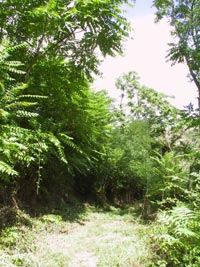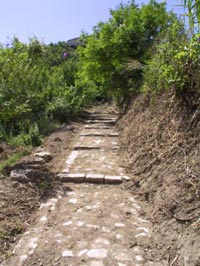At
the beginning of the XX century in the east side of Calitri’s territory,
along a steep slope, was built a mule-track that allowed to reach the
quarters of Cortino and Piano dei Monti where a lot of peasants had their
little pieces of ground.
The pavement was made using the stones taken from Cortino stream, and
for the retaining walls those extracted from the pits of Tufiello.
This short-cut allowed people to save a lot of time and to pass through
in winter months, when other paths made only of excavated earth were impassable
for the bad weather.
That way was an example of hard work but also of respect for nature, because
it didn’t take away nothing that wasn’t strictly necessary
to make man-work lighter. The path still winds among
oaks, poplars, elms, locust-trees, brooms and hawthorns.

|
Those who were
used to walk on it smelled the scent of flowers and bushes when
weren’t too tired for work, never thinking that one day
it could have been walked with others purposes. A lot of time
passed since those days, and nowadays in Calitri we don’t
see donkeys and mules anymore and nobody goes to his holdings
in the country through this way, only some who don’t want
to drive and prefers to take a relaxing walk. |
|||
 |
|||
